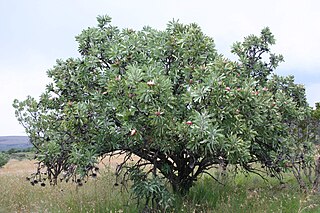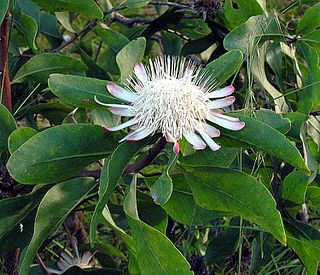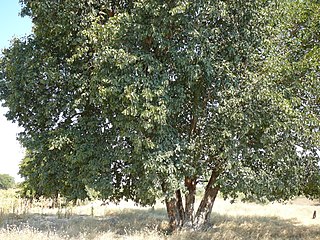
Protea caffra, native to South Africa, is a small tree or shrub which occurs in open or wooded grassland, usually on rocky ridges. Its leaves are leathery and hairless. The flower head is solitary or in clusters of 3 or 4 with the involucral bracts a pale red, pink or cream colour. The fruit is a densely hairy nut. The species is highly variable and has several subspecies.

Protea gaguedi is a species of tree which belongs to the genus Protea.

Protea welwitschii is a species of shrub or small tree which belongs to the genus Protea, and which occurs in bushveld and different types of grassland.

Baikiaea plurijuga, known as African teak, Mukusi, Rhodesian teak, Zambian teak or Zambesi redwood, is a species of Afrotropical tree from the legume family, the Fabaceae from southern Africa.

The wildlife of Zambia refers to the natural flora and fauna of Zambia. This article provides an overview, and outline of the main wildlife areas or regions, and compact lists of animals focusing on prevalence and distribution in the country rather than on taxonomy. More specialized articles on particular groups are linked from here.

Aeschynomene elaphroxylon, also known as an ambatch, pith-tree, balsa wood tree, or umburu, is a common large shrub to small tree of the genus Aeschynomene in the family Fabaceae growing in swamps, lakes and rivers in Tropical Africa. It grows two to nine, exceptionally up to twelve, metres high, with a straight, thick, swollen, conical trunk. This is an unusual leguminous tree in that it grows in water as a freshwater mangrove, with an extremely lightweight wood acting as a float and a specialised root system sprouting from the trunk which forms a tangled web hanging through the water and sprawling through the mud. It has adventitious roots and roots which are differentiated into special structures adapted to the swamp environment. It can even grow as floating islands of drifting forests.

Olyra latifolia, commonly known as carrycillo, is a species of bamboo in the grass family Poaceae. It occurs in Mexico, Central and South America, and in sub-Saharan Africa. It is a common species, up to 5 m (16 ft) tall, growing prolifically in rainforests, particularly near the margins.

Ceratotheca is a genus of plants in the family Pedaliaceae comprising about five species native to worldwide tropical areas and to southern Africa.

Drimia elata is a species of flowering plant in the family Asparagaceae, subfamily Scilloideae. It is widely distributed in eastern and southern Africa.

Commiphora schimperi, also known as glossy-leaved corkwood, is a tree species in the genus Commiphora. It is native eastern and southern Africa and the southern Arabian Peninsula, from Sudan and Yemen in the north to Botswana and northern South Africa in the south.
Zanha is a small genus of plants in the family Sapindaceae that are native to Africa.

Felicia mossamedensis or yellow felicia is a well-branched, roughly hairy, annual or perennial plant of up to 30 cm (1 ft) high, assigned to the family Asteraceae. It has alternately arranged, seated, flat to slightly succulent, broad-based, entire, blunt tipped leaves. The flower heads sit individually on top of a stalk of up to 8 cm (3 in) long, have an involucre of three whorls of bracts, many yellow ray florets and many yellow disk florets. It can be found in southern Africa, in Zimbabwe, Mozambique, Botswana, Eswatini, South Africa and on the coast of Angola.

Drypetes arguta, commonly known as the water ironplum, is a species of small tree or large bush in the family Putranjivaceae. It is native to tropical East Africa. It was first described in 1920 by the English botanist John Hutchinson, who named it Cyclostemon argutus. It was later transferred to the genus Drypetes.
Vachellia kirkii, widely known as Acacia kirkii but now attributed to the genus Vachellia, is a tree native to tropical Africa. It is commonly known as the flood plain acacia.

Protea dracomontana, the Nyanga protea or the Drakensberg sugarbush, is a flowering plant that belongs within the genus Protea. The plant is found in the Eastern Cape, Lesotho, KwaZulu-Natal and the escarpment of the Free State, as well as eastern Zimbabwe. In Zimbabwe this species is only known from a disjunct subpopulation confined to the summit of Mount Nyangani.

Protea madiensis, commonly known as the tall woodland sugarbush, is a flowering shrub which belongs to the genus Protea. It is native to the montane grasslands of Sub-Saharan Africa.

Gardenia volkensii, commonly known as bushveldt gardenia or Transvaal gardenia, is a species of plant in the family Rubiaceae native to southern Africa.

Mundulea sericea, the cork bush, is an attractive shrub or small tree which is found in relatively open woodlands of Africa and South Asia. It is the only member of the genus with a range extending beyond Madagascar, and it resembles some African shrubs in the related genus Tephrosia.
Vepris bremekampii, the wart-berry or wild mandarin, is a species of flowering plant in the family Rutaceae, native to southern Mozambique and northern South Africa. An evergreen shrub or small tree reaching 6 m (20 ft), its 1.4 cm (0.6 in) fruit are wrinkled and warty with a resemblance to Citrus.
















